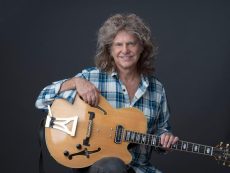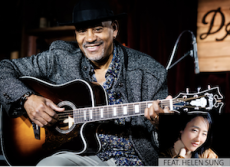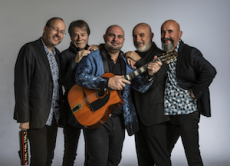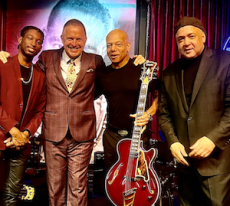
AN EVENING WITH PAT METHENY
An Evening with Pat Metheny w/ Antonio Sanchez, Linda May Han Oh & Gwilym Simcock
NEA Jazz Master Pat Metheny first burst onto the international jazz scene in 1974. Over the course of his three-year stint with vibraphone great Gary Burton, the young Missouri native already displayed his soon-to-become trademarked playing style, which blended the loose and flexible articulation customarily reserved for horn players with an advanced rhythmic and harmonic sensibility – a way of playing and improvising that was modern in conception but grounded deeply in the jazz tradition of melody, swing, and the blues. With the release of his first album, Bright Size Life (1975), he reinvented the traditional “jazz guitar” sound for a new generation of players. Throughout his career, Pat Metheny has continued to re-define the genre by utilizing new technology and constantly working to evolve the improvisational and sonic potential of his instrument. Metheny’s versatility is almost nearly without peer on any instrument. Over the years, he has performed with artists as diverse as Steve Reich to Ornette Coleman to Herbie Hancock to Jim Hall to Milton Nascimento to David Bowie. Metheny’s body of work includes compositions for solo guitar, small ensembles, electric and acoustic instruments, large orchestras, and ballet pieces, with settings ranging from modern jazz to rock to classical.
Showtimes:
More Posts: adventure,album,club,genius,guitar,jazz,museum,music,preserving,restaurant,travel

BELA DONA
Washington DC is the birthplace of this exciting and diverse all-female band.The high-energy concert style presentation and dynamic musicianship exuded on stage is the selling point of these phenomenal ladies.
Their unique style of Funk, Jazz, R&B and Rock command an impressive drawing power attracting many beloved fans and local promoters. Individually, each band member has toured with various national artists such as Nile Rodgers(Chic), Pieces of a Dream, Chuck Brown, High Five, EU, Salt & Pepa, Pleasure, Stephanie Mills, Ginuwine, Crystal Waters, and many others.
Vocals: Sweet Cherie ~ MD/Keys, Karis Hill ~ MC, Kim Scott; Chella Davis; Taylor Gamble ~ Guitar; Shannon Browne ~ Drums; Tempest “Storm” Thomas ~ Bass, Claudia”Kool Keys”Rodgers ~ Keys; Natarsha Proctor ~ Percussion
Actual Showtime:
Streaming: Thu, July 28, 7:30 PM | $10 + $1.70 fee
Live: Thu, July 28, 7:30 PM | $30 – $35 + $3.10 – $3.46 fee
More Posts: adventure,album,bass,club,drums,genius,guitar,jazz,keys,museum,music,percussion,preserving,restaurant,travel,vocal

ALLAN HARRIS BAND
The musical odyssey of Allan Harris visits a wide range of influences, including swinging jazz, rich R&B, sumptuous balladry, wailing rock, rumbling blues and even a playful touch of Brazilian music.
With a deeply resonant baritone/tenor voice that is soulful, richly expressive and flawless in both intonation and phrasing, Harris displays a total command and fluency while on stage.
Show Times: 7:00 pm & 9:30 pm
More Posts: adventure,album,club,genius,guitar,jazz,museum,music,preserving,restaurant,travel,vocal

DJANGO FESTIVAL ALL~STARS
Hot Gypsy Jazz
The Django Festival Allstars, from France, tour the US 2x a year, playing at America’s top halls and clubs including Carnegie Hall and Rose Hall. The Allstars have performed at SF Jazz, Newport Jazz Festival, Montreal Festival, Kennedy Center, Aspen, Taos, Vale, and Moody Festivals, and Birdland for 22 years, all to great acclaim!
Django’s unmistakable cool and jumpin’ jole de vivre have made him an icon for an unlikely range of luminaries from Carlos Santana to Eric Clapton, guitar greats! Jimi Hendrix named his “big band of gypsies” in tribute, and Willie Nelson adopted his influence in “country-swing.”
The Django Festival Allstars, have grown into a brilliantly cohesive group of star musicians who’ve taken America by storm, performing at top concert halls and festivals to standing ovations. The Django Festival Allstars bring this music to ‘today’ combining known standards and original music… intoxicating!
Show Times: 7:00 pm & 9:30 pm
More Posts: adventure,album,club,genius,guitar,jazz,museum,music,preserving,restaurant,travel

JOE FARNSWORTH/MARK WHITFIELD TIME TO SWING QUARTET
Joe Farnsworth/Mark Whitfield TIME TO SWING Quartet
One of the most highly regarded jazz drummers on the scene today, Joe Farnsworth is known for his blazing speed, precision, musical, and melodic playing.
Joe Farnsworth~drums,
Mark Whitfield~guitar,
Peter Washington~bass
Julius Rodriguez~piano
Streaming Pass ~ $10.00
Shows: 7:30 & 10:00 pm each night
More Posts: adventure,album,club,drums,genius,guitar,jazz,museum,music,preserving,restaurant,travel

